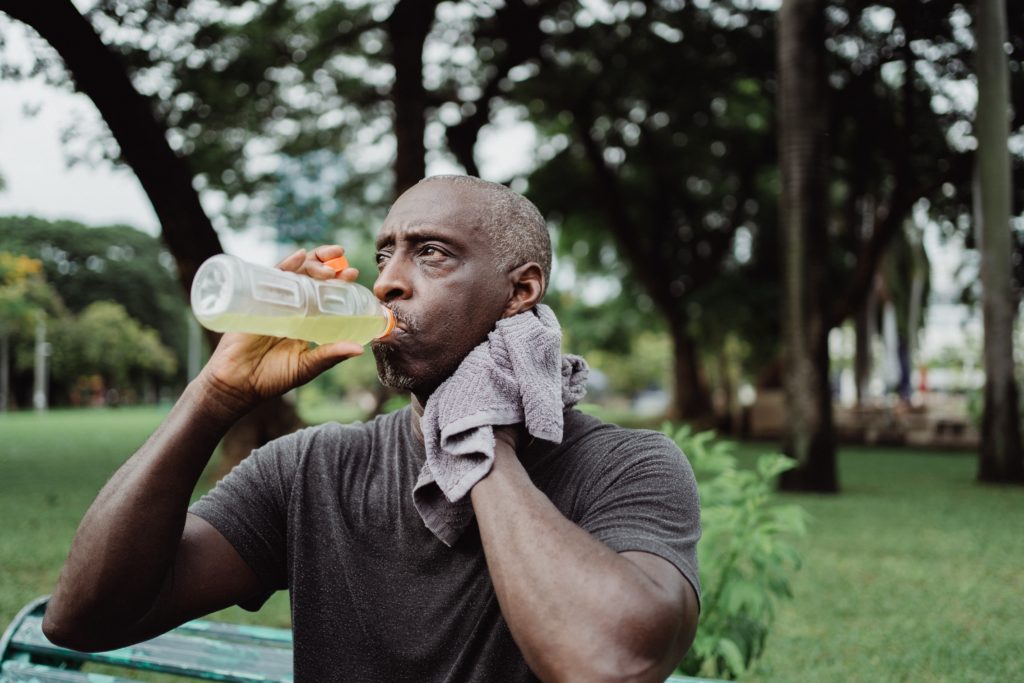What Is Sweat Rate?

No matter where you are, summer workouts are tough. Heat and humidity are two of the toughest elements to deal with while training. During the summer, you often feel like you finish a run “drenched”, and running the same paces feels hard. In contrast, with winter running, you sweat a lot less, and usually running certain paces will feel easier.
However, no matter the season, every person sweats differently. This difference in the amount you sweat indicates a difference in how you should hydrate. We know everyone needs to hydrate, but figuring out how much hydration and electrolytes you need is very personalized. As a result, finding your sweat rate will help you run better.
The average person sweats 27-47 ounces per hour. But what does that even mean? How can finding out your sweat rate help you as a runner?
What Is Sweat Rate?
Sweat rate is calculating the amount of fluid you’ve lost during exercise. The main function of sweat is to control body temperature. As the water in the sweat evaporates, the surface of your skin cools. What’s left on your skin is salt. That’s why you might sometimes find yourself with a layer of salt caked on your body after a workout.
Especially while running in the summer, it is important to monitor your sweat rate. Why? During exercise, sweating causes fluid and salt losses. This loss reduces plasma volume which leads to higher heart rate and a reduction in performance. The more depleted you are, the harder it is to maintain the same effort. That’s why when you are dehydrated, paces will feel harder. Not only that, but dehydration can also get dangerous, potentially causing a heat related illness.
Is Temperature A Factor In Sweating?
Of course! That is why summer running feels “harder” than spring, fall, and winter. Different climates affect people differently as well. Humid conditions and dry heat have different effects on our bodies. In addition to calculating sweat rate and properly hydrating, it’s also important to properly acclimate to the weather.
How Can You Calculate Your Sweat Rate?
The easiest way to measure your sweat rate is to weigh yourself naked before exercising for 1 hour. After you’ve exercised for an hour, dry off and weigh yourself naked again. Subtract the “before” weight from the “after”. This assumes you did not have anything to drink or use the bathroom during your workout. For each pound lost, that is equivalent to 15.4 ounces of fluid.
If you do consume fluids during your run, you’ll need to add the amount of fluid consumed to the total weight loss. If you use the bathroom, estimate the amount of weight lost and subtract it from the total weight lost.
Finally, it’s a good idea to do this test a few different times in different weather conditions. That way, you can get a good idea of your sweat rate in different conditions. Weather makes all the difference, and your sweat rate will be different in cool conditions versus hot ones. It will even be different in dry heat versus humid heat! And of course, you sweat differently in different sports, too. Your sweat rate will be different in running, swimming, biking, or any endurance activity.
Now What?
After you have your sweat rate data, what do you do next? Research has shown that hydration is more complex than drinking what you just sweat out. For instance, drinking 100% replacement requires drinking when you aren’t thirsty. Going against your body’s natural thirst requirements can often lead to hyponatremia. This is when sodium levels in the blood are lower than normal, usually because too much water dilutes the sodium in your body. Hyponatremia can be just as devastating on the body as dehydration.
You don’t need to make a strict “hydration plan” with your data. Instead, think of your hydration plan as a “guesstimate” or rough idea of what you should be drinking throughout your exercise. Just because you aren’t getting a heat related illness during a workout doesn’t mean hydrating more won’t benefit you.
You can also use your sweat rate information to develop a rehydration plan that’s appropriate for your body. For every 16 ounces of fluid you lose, you should aim to consume about 20 ounces after your workout.
Developing an appropriate hydration strategy before, during, and after a workout is one of the best things you can do for your body. No one wants a heat related illness or a bad training session due to hydration issues.

Hollie is a runner, hiker, swimmer, residing in California. She has worked in run specialty for nearly 8 years and has fit hundreds of people for shoes. Outside of the running world, she enjoys the general aviation world, her two cats, and spending time with her spouse.









